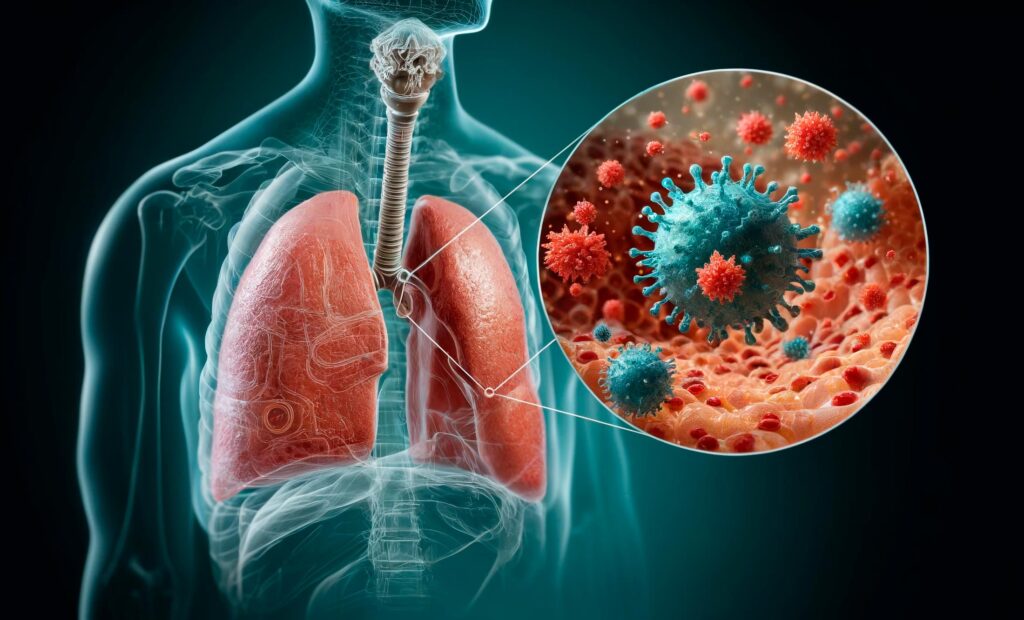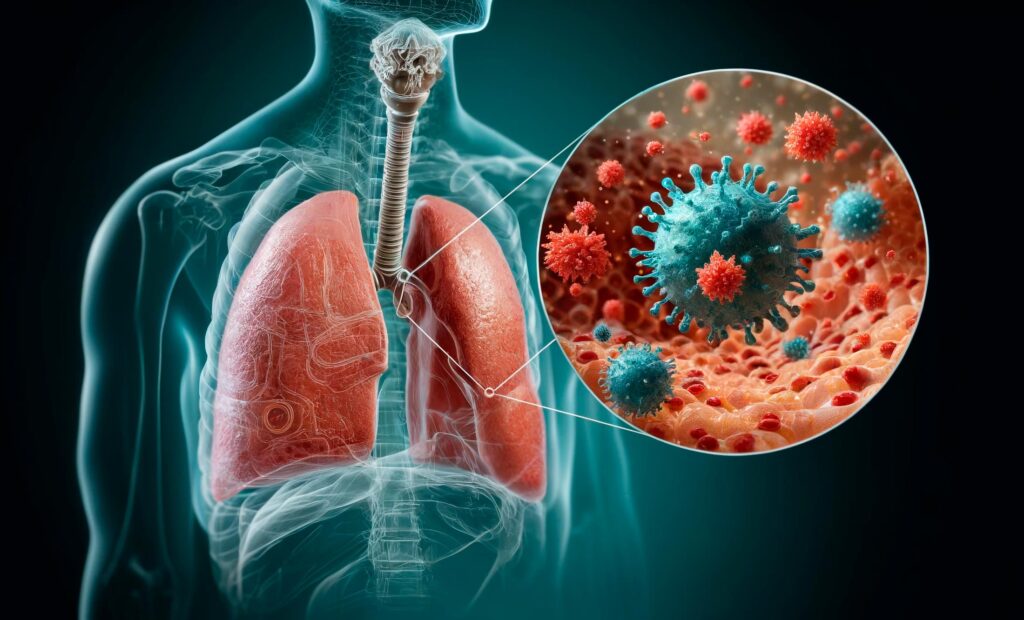
The immune system defends the body through coordinated actions between innate (immediate) and adaptive (targeted) responses. Barriers, white blood cells, interferons, antibodies, and memory cells detect, attack, and remember viruses, ensuring both quick protection and long-term immunity.
Key Takeaways
- Innate immunity provides the first defense using barriers, white blood cells, and interferons.
- Adaptive immunity uses T-cells and B-cells for precise viral targeting and antibody production.
- Interferons create an antiviral state, blocking viral replication and alerting neighboring cells.
- Antigen-presenting cells activate T-cells and coordinate immune communication.
- Memory cells ensure faster, stronger responses to future infections.
- Vaccines, nutrition, rest, and emerging therapies strengthen viral defense and immune readiness.
What is the Immune System?
The immune system is the body’s natural defense against infections and diseases. It is made up of different parts that work together to protect you from germs, viruses, and harmful substances.
- White blood cells: These special cells travel through the blood, looking for signs of infection and attacking invaders.
- Lymph nodes: Small glands that help filter out germs and alert the body to infection.
- Skin and mucous membranes: Act as physical barriers to block germs from entering the body.
- Bone marrow and spleen: Help produce and store important immune cells.
- Two levels of protection: The immune system responds quickly with general defense (innate immunity) and builds specific defenses that remember and fight germs if they come back (adaptive immunity).
What Happens When a Virus Enters the Body?

When a virus enters your body, it tries to invade your cells and make copies of itself. The immune system quickly notices these invaders and starts its defense.
- Viruses enter through the nose, mouth, eyes, or open wounds
- They attach to healthy cells and release their genetic material
- Infected cells send out distress signals to alert the immune system
- The immune system gets activated to fight off the infection
Innate Immune Response: The First Line of Defense
The innate immune response acts within minutes or hours. It is the body’s immediate, non-specific response to anything unfamiliar.Before diving into the list, know that the innate immune system doesn’t need to learn or remember the invader. It simply acts fast.
- Physical barriers like skin and mucous membranes block viruses from entering
- Stomach acid kills many viruses that are swallowed
- White blood cells such as macrophages patrol and swallow invaders
- Natural killer (NK) cells destroy infected cells before viruses can multiply
- Cytokines and chemokines are chemical messengers that attract more immune cells and start inflammation, which contains the infection
Interferons and the Antiviral State
When your body detects a viral infection, one of the first steps it takes is to release special proteins called interferons. These proteins play a critical role in slowing down or stopping the virus before it can spread.Interferons are like early warning signals for your cells. Here’s what happens:
- Infected cells produce interferons soon after a virus enters and starts replicating inside them.
- These interferons are released and spread to nearby healthy cells.
- Healthy cells, after receiving the signal, begin to change their internal defenses.
- They start making their own antiviral proteins, which block the virus from copying itself.
- This creates what is called an “antiviral state” in the surrounding cells, making it much harder for the virus to spread.
Types of Interferons
There are a few types of interferons, mainly called Type I (like interferon-alpha and interferon-beta) and Type II (interferon-gamma). Each type has a slightly different role, but all help limit viral infections.
Other Effects of Interferons
Interferons don’t just help nearby cells. They also:
- Alert other parts of the immune system to increase their defenses
- Make infected cells easier targets for killer immune cells
- Help control inflammation, so damage from the infection is limited
Antigen Presentation and Communication
When a virus invades your body, your immune system needs to identify exactly what it’s fighting. Antigen presentation is the process that makes this possible. This step is crucial because it helps direct the immune response to the right target.
Antigens are tiny pieces of the virus, like its proteins, that your body can recognize as foreign. Here is how your immune system uses them:
- Infected cells break down viruses into smaller pieces and display these pieces (antigens) on their surface.
- This display happens using special molecules called major histocompatibility complexes (MHC).
- Antigen-presenting cells (APCs) such as dendritic cells, macrophages, and B-cells are expert at picking up antigens from viruses.
- These APCs travel to the lymph nodes, which act as meeting points for immune cells.
- In the lymph nodes, APCs show the viral antigens to T-cells.
- T-cells examine these antigens closely. If they recognize the virus, they get activated and begin organizing the rest of the immune system to attack.
Adaptive Immune Response: The Targeted Attack
This part of the immune system learns and adapts to new threats. It takes a bit longer to get started, but it is more powerful and precise.
- Helper T-cells (CD4+) coordinate the immune response by signaling other cells
- Cytotoxic T-cells (CD8+) identify and kill virus-infected cells directly
- B-cells recognize the virus and create antibodies that stick to it
- Once activated, these cells multiply rapidly to attack the infection
- Some of these cells become memory cells, so the body can respond faster next time
Neutralizing Viruses: How Antibodies Work
Antibodies are powerful tools that your immune system uses to stop viruses in their tracks. When your body senses a virus, it produces these special proteins to protect you.
Before we get into the details, it’s helpful to know that antibodies are made by B-cells, a type of white blood cell. Each antibody is shaped to fit a specific virus, almost like a lock and key.
Here’s how antibodies help defend you from viruses:
- Antibodies bind to viruses directly
When antibodies attach to a virus, they cover the parts the virus uses to enter your cells. This blocks the virus from infecting healthy cells. - They label viruses for destruction
Antibodies act like flags, marking viruses so that other immune cells, such as macrophages, can find and destroy them more easily. - Antibodies can join with other proteins
When antibodies bind to a virus, they can also activate the complement system, a group of proteins that helps punch holes in viruses or infected cells to destroy them. - Different types of antibodies work at different times
IgM antibodies are made early during an infection and help slow the virus right away.
IgG antibodies appear later but are stronger and last longer, providing ongoing protection.
Elimination of Infected Cells
Once your immune system identifies cells that have been infected by a virus, the next step is to remove these cells before the virus can spread any further. This process is tightly controlled to limit harm to healthy tissue.
Here’s how the immune system eliminates infected cells:
- Cytotoxic T-cells (also called killer T-cells) are specialized immune cells that patrol the body looking for infected cells.
- These T-cells check the surface of cells for viral antigens, which are pieces of the virus displayed by the infected cell.
- When a cytotoxic T-cell recognizes a cell displaying these viral antigens, it attaches to the infected cell.
- The T-cell then releases toxic substances that cause the infected cell to break apart and die.
- This method, called apoptosis, is a form of programmed cell death. It helps contain the virus and prevents it from infecting more cells.
- After the infected cell is destroyed, other immune cells clean up the remains.
Immunological Memory and Long-term Protection
After your immune system fights off a virus, it doesn’t forget the battle. Instead, it creates a memory of the virus, which is what gives you long-term protection. This ability to remember past infections is called immunological memory.
Immunological memory works in a few important ways:
- Memory cells are formed
After the first infection, some T-cells and B-cells become memory cells. These cells live in your body for years, sometimes for a lifetime. - Quick response to repeat infections
If the same virus tries to infect you again, memory cells react much faster than during the first encounter. They multiply and launch a rapid defense, often stopping the virus before you feel sick. - Stronger and longer-lasting immunity
Because of memory cells, your immune system’s second response to a virus is stronger and more effective than the first. - Vaccines use this natural process
Vaccines introduce a harmless part of a virus to your immune system, training it to create memory cells without you having to get sick. That way, your body is ready to fight if you ever come into contact with the actual virus.
Viral Evasion Strategies: How Viruses Outsmart Immunity
Viruses have developed ways to hide or escape from the immune system. This is why some infections are hard to treat.
- Some viruses change their surface proteins to avoid recognition
- Others hide inside cells or block the immune system’s signals
- Viruses like HIV directly attack immune cells
Disorders and Failures: When the Immune System Misfires
Sometimes, the immune system doesn’t work properly. This can make it hard to fight off viruses or can cause the body to attack itself.
- Autoimmune diseases occur when the immune system attacks healthy cells
- Immunodeficiency happens when the immune system is weak or incomplete
- Chronic infections like HIV and hepatitis can overwhelm the immune response
- In some viral infections, the immune system overreacts and causes dangerous inflammation
Boosting and Supporting Immune Response Against Viruses
Supporting your immune system can help it fight off viruses more effectively.
- Vaccines train the immune system by exposing it to harmless parts of the virus
- Good nutrition and healthy sleep support immune cell function
- Regular physical activity and stress management help maintain balance
- Antiviral medicines can assist the immune response in severe cases
Future Research and Advances
Research is constantly improving our understanding of the immune system and its battle with viruses.
- New therapies like monoclonal antibodies are being developed to target viruses
- Scientists are using genetic tools like CRISPR to explore new treatments
- Vaccine technology continues to advance, making protection faster and safer
Conclusion
The immune system protects the body from viruses through a coordinated defense. Physical barriers like skin and stomach acid block entry, while white blood cells respond quickly to infection. Infected cells release interferons that alert neighboring cells. Antigen-presenting cells identify viruses and activate T-cells and B-cells, leading to targeted attacks.
Antibodies produced by B-cells block viruses and mark them for destruction, while killer T-cells destroy infected cells. Memory cells ensure faster responses if the same virus returns. Vaccines, healthy habits, and new treatments strengthen this defense, helping the body stay prepared against viral infections.
FAQs
How do vaccines help the immune system recognize viruses?
Vaccines teach your immune system to recognize and respond to a virus without causing disease. This helps you develop memory cells for fast protection.
What’s the difference between innate and adaptive immunity?
Innate immunity is immediate and non-specific, while adaptive immunity is slower but highly specific and creates memory for future infections.
How do antibodies neutralize viruses?
Antibodies attach to viruses and block them from infecting cells. They also tag viruses for destruction by other immune cells.
Can the immune system remember all viruses it has encountered?
The immune system can remember many viruses, but some mutate so quickly that memory cells may not recognize them as easily.
Why do some viruses evade immune detection?
Viruses can change their surface proteins or hide within cells, making it hard for the immune system to detect and destroy them.
How does the body distinguish between viral and bacterial infections?
The immune system uses pattern recognition and specific signals to identify if the invader is a virus or bacteria, leading to a tailored response.
What causes a cytokine storm during viral infections?
A cytokine storm is an excessive immune reaction where too many chemical signals cause widespread inflammation, which can be harmful.
How do immunodeficiency disorders affect viral immunity?
These disorders weaken the immune response, making it harder to fight off viruses and increasing the risk of infection.
Can lifestyle changes improve viral immunity?
Yes, healthy habits like balanced nutrition, exercise, and enough sleep support the immune system’s ability to fight viruses.
Are new technologies like monoclonal antibodies effective against all viruses?
Monoclonal antibodies are promising for some viruses, but not all. Their effectiveness depends on the virus and the specific treatment.
Reference
- Crotty, S., & Ahmed, R. (2004). Immunological memory in humans. Seminars in Immunology, 16(3), 197–203. https://doi.org/10.1016/j.smim.2004.02.008
- Chaplin, D. D. (2010). Overview of the immune response. Journal of Allergy and Clinical Immunology, 125(2 Suppl 2), S3–S23. https://doi.org/10.1016/j.jaci.2009.12.980
- Ivashkiv, L. B., & Donlin, L. T. (2014). Regulation of type I interferon responses. Nature Reviews Immunology, 14(1), 36–49. https://doi.org/10.1038/nri3581
- Forthal, D. N. (2014). Functions of antibodies. Microbiology Spectrum, 2(4). https://doi.org/10.1128/microbiolspec.AID-0019-2014
- Sallusto, F., Lanzavecchia, A., Araki, K., & Ahmed, R. (2010). From vaccines to memory and back. Immunity, 33(4), 451–463. https://doi.org/10.1016/j.immuni.2010.10.008
- Alcami, A., & Koszinowski, U. H. (2000). Viral mechanisms of immune evasion. Trends in Microbiology, 8(9), 410–418. https://doi.org/10.1016/S0966-842X(00)01835-1
Aubrey Carson is an RDN with 9 years across hospital, outpatient, and private practice settings. They earned an MS in Clinical Nutrition from Tufts University – Friedman School (2016) and completed a Dietetic Internship at Mayo Clinic. Aubrey specializes in micronutrient assessment, evidence-based supplementation, and patient education. Their work includes CE presentations for the Academy of Nutrition and Dietetics and collaborations with Mass General Brigham on nutrition education resources.


